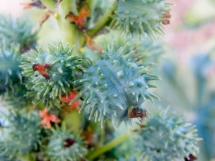Origin
Castor bean is a shrub native to the Mediterranean Basin and common in tropical regions, gorwing up to 15 feet high. In the Santa Clara River it grows as a perrenial. It has the highest raiting of toxicity by the California Posion Control System, due to the low concentrations of ricin in the seeds.
Ecological Effects
Castor bean is similar to other invasive species studied along the Santa Clara River. The seeds easily germinate after fires or other land disturbances and displace native vegetation. The ricin in the seeds can cause poisoning in cattle, other animals and humans if ingested or significantly inhaled. Parasites in the soils are also subject to poisoning by this plant (Cal IPC), as are smaller insects such as aphids, causing research to now focus on the possibilities of using ricin as an insecticide.
Biological Control
Castor oil is commonly used as vegetable oil, and components of the ricin poison found in the seeds are used medicically as laxatives and dermatological problems. Due to this, it is grown as a crop in California and therefore are no bioloical control efforts. Instead, manual and chemical methods are commonly used in the Santa Clara River to aid in its eradication.


 Close up of seeds
Close up of seeds